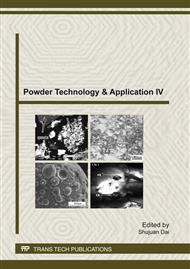p.279
p.285
p.292
p.299
p.305
p.310
p.315
p.320
p.324
Study on Adsorption Properties of Different Dyes on Montmorillonite
Abstract:
Using Octadecyltrimethylammonium cations with long carbon chain to modify calcium montmorillonite samples, the adsorption properties of different dyes on montmorillonite before and after modification were investigated. Results showed that the basic dye of methylene blue was easily adsorbed by natual calcium montmorillonite, while the adsorption ability for acid blue and neutral blue was greatly improved when it was organically modified, and the adsorption amount increased with the increasing of modifier dosage. The adsorption ratio was influnced by reaction time, the temperature and the solution’s pH value. It suggested that the adsorption balance time was about 60min; higher temperature was good for acid blue adsorbed on organic montmorillonite, but neutral blue’s adsorption amount was greater at the room temperature; the optimum pH was 9 for methylene blue adsorption, while low pH was better for acid blue and neutral blue adsorption.
Info:
Periodical:
Pages:
305-309
Citation:
Online since:
January 2012
Authors:
Keywords:
Price:
Сopyright:
© 2012 Trans Tech Publications Ltd. All Rights Reserved
Share:
Citation:


